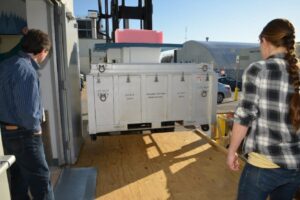
The handling and transport of your equipment will influence your protective case design.
If you are ready to find the perfect transit and shipping case for your valuable equipment, you should first understand your expectations for any protective packaging needs. Case performance expectations are often influenced by the handling and transport your products are expected to endure. Packaging Strategies, Inc. will work with you to assess your handling and transport needs so we can design a case with the best exteriors and interiors your equipment needs, to stay completely safe during shipment.
How Handling Influences Your Case Design
How protective cases are to be transported or moved around is an essential factor to consider when determining what protective measures are required.
If your case is small and light enough for one or two individuals to carry, you can assume that, at some point, the case may be dropped due to natural human error. Depending on the case’s size and the handles’ orientation, you may expect that item to be dropped from approximately 24” to 30” in height. Calculating this impact can help you plan for the protective design needed to ensure that these drops do not impact or damage your equipment.
Large, heavy items are typically handled using pallet trucks and forklifts. In this instance, you have to account for the risk of the item being strapped down incorrectly and potentially falling off the pallet. For example, if your item is over 200lbs, there is a lessened probability of a high-drop, but the load could be lowered too quickly and drop from a height of about 8” to 12”.
Considering Possible Transportation Errors
Similarly, when considering the potential for damage during transportation, lightweight items are subject to different experiences than heavier items or cases. Lightweight cases may be handled more frequently by hand or slide around inside of a transportation vehicle more easily, which makes them vulnerable to impact on any face, corner, or edge of the case. Realizing this, you can create a protective case design with thicker exterior walls, sturdy shock mounts and custom foam inside that protects equipment from all angles.
Large, heavy items transported by pallet trucks and forklifts are often tilted as they are picked up and lowered, so one edge or corner will contact the floor first. This means if the case drops, the edges or corners may get the brunt of the impact. For these large protective cases, the focus should be placed on providing shock and impact protection along the corners and edges both on the inside and outside of the case.
You want to avoid tall cases when you can. The case height should be at most 1.5 times its width which helps maintain stability. If the height exceeds the 1.5x factor, you can assume the case will likely tip over at some point. In that instance, you should reinforce the side walls to protect your equipment from drops and impacts.
DEPEND ON PACKAGING STRATEGIES FOR YOUR CUSTOM PACKAGING NEEDS
Packaging Strategies has assembled a team with over 80 years of experience in design, engineering, development, manufacturing, and sales. We created the Packaging Strategies Design and Technology Center to create and manufacture complete systems integration packages and container solutions of all sizes and materials for our clientele. Many of these clients are federal agencies or in the private sector. No matter what you need to carry, Packaging Strategies is sure to have the right case for the job. You can view our website here, and follow us on Facebook, Twitter, Flickr, and LinkedIn.
This entry was posted on Tuesday, January 31st, 2023 at 11:44 am. You can follow any responses to this entry through the RSS 2.0 feed. You can leave a response, or trackback from your own site.